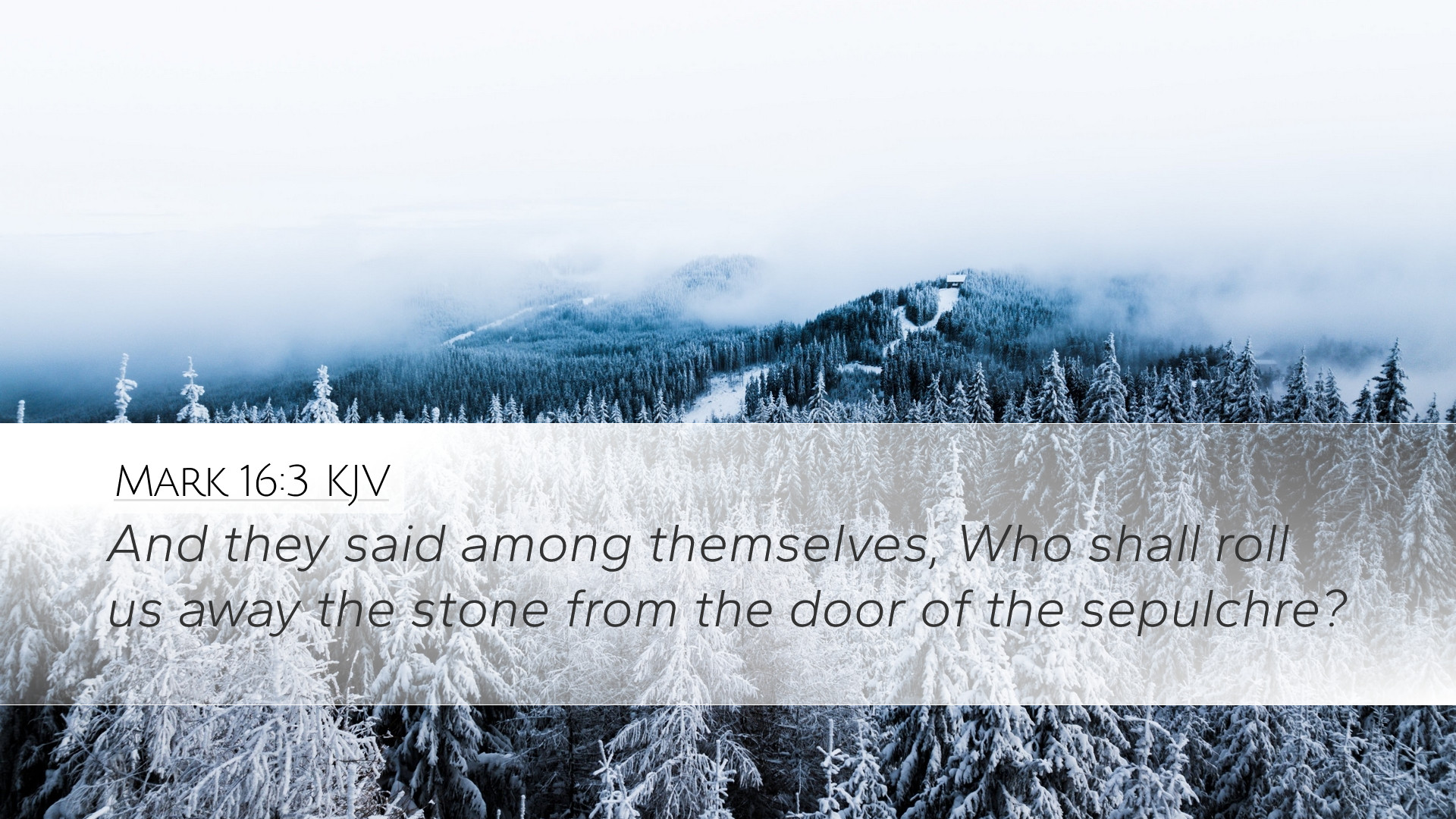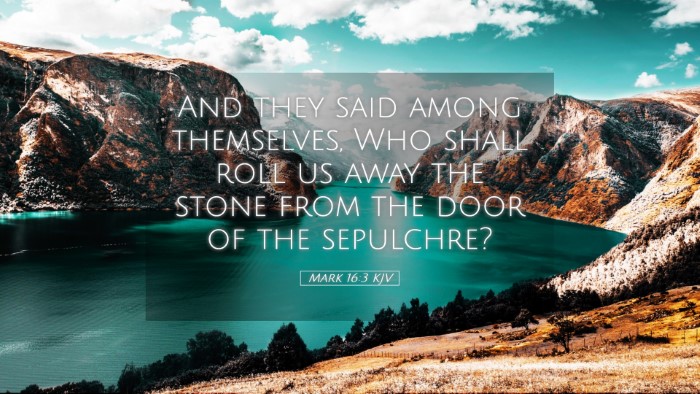Old Testament
Genesis Exodus Leviticus Numbers Deuteronomy Joshua Judges Ruth 1 Samuel 2 Samuel 1 Kings 2 Kings 1 Chronicles 2 Chronicles Ezra Nehemiah Esther Job Psalms Proverbs Ecclesiastes Song of Solomon Isaiah Jeremiah Lamentations Ezekiel Daniel Hosea Joel Amos Obadiah Jonah Micah Nahum Habakkuk Zephaniah Haggai Zechariah MalachiMark 16:3
Mark 16:3 KJV
And they said among themselves, Who shall roll us away the stone from the door of the sepulchre?
Mark 16:3 Bible Commentary
Commentary on Mark 16:3
Verse Reference: Mark 16:3 - "And they said among themselves, Who shall roll us away the stone from the door of the sepulchre?"
Introduction
The account found in Mark 16:3 occurs post-crucifixion as the women approach the tomb of Jesus. Their concern about the stone signifies a deeper spiritual realization and sets the stage for the miraculous events that follow. In this commentary, we delve into the insights from various public domain sources to explore the theological and practical implications of this verse.
Contextual Background
Historical and Cultural Context: This verse reflects the practices of burial during the time of Jesus. Tombs were often sealed with large stones to ensure security against grave robbers and animal intrusions. The presence of women approaching the tomb not only highlights their devotion but underscores the cultural implications of their role in the resurrection narrative.
Insights from Commentaries
Matthew Henry's Commentary
Matthew Henry emphasizes the women’s realistic concern regarding the stone's weight and position. He notes that they did not initially have faith in the resurrection promise, which mirrors the struggles of believers to trust in God's power:
- Faith versus Doubt: Henry suggests this moment reveals the duality of human faith. The women knew their duty to attend to Jesus' body but questioned who would assist them in their task.
- The Unseen Power of God: While they pondered the obstacle, God had already dispatched an angel to roll away the stone. This demonstrates that even in our doubts, God is at work beyond our comprehension.
Albert Barnes' Notes
Barnes reflects on the emotional state of the women as they approach the tomb:
- Despair and Determination: Their query about the stone symbolizes the despair faced in loss but also highlights their determination to fulfill their duty. This paradox serves as a poignant reminder of the human tendency to seek closure while overlooking divine possibilities.
- Symbolism of the Stone: The stone can be viewed as a barrier to faith. Barnes notes that just as the stone was rolled away, so too can the barriers of our hearts be removed through faith in Christ’s resurrection.
Adam Clarke's Commentary
Clarke expounds on the implications of the women's concern:
- Empowerment through Action: Clarke remarks that their proactive approach to the tomb signifies a loving, faithful response in the face of challenges. Their question underlines human limitation in the face of divine events.
- Foreshadowing Resurrection: The act of opening the tomb serves as a metaphor for the greater resurrection event—first, Christ's, and subsequently, the believers’ hope in eternal life.
Theological Significance
Theological reflections from Mark 16:3 can be multifaceted:
- Human Efforts vs Divine Intervention: The initial concern of the women reminds us of human inability to overcome sin and death. It highlights the necessity of divine intervention for salvation.
- The Role of Women in Scripture: Their significant role in the resurrection narrative asserts the value and agency of women in the early Church, challenging contemporary societal norms.
- Hope Amidst Doubt: The verse serves as a reminder that through despair, hope can emerge. It encourages believers to recognize that God’s plans surpass human understanding.
Practical Applications for Pastors and Leaders
This verse invites leaders to reflect on several applications:
- Encouragement in the Face of Challenges: Pastors may use this narrative to teach that challenges in ministry can often seem insurmountable, yet God is often at work beyond what we can see.
- Empowerment of the Congregation: Encourage congregants to take action in service, even amidst uncertainty, trusting in God’s providence to support them.
- Recognizing Barriers: Address the obstacles faced within the church community and illustrate that, like the stone, some barriers can only be moved through collective faith and prayer.
Conclusion
Mark 16:3, though seemingly straightforward, opens a rich tapestry of faith, doubt, and divine action. The insights from historical commentaries guide us in understanding not only the historical context but also the profound spiritual implications. Believers are called to recognize the power of God that operates even when we, like the women, are blinded by our doubts and fears. As they moved forward, trusting that someone would help them, we too are invited into the journey of faith where God is ever present, rolling away the stones that bind us.


